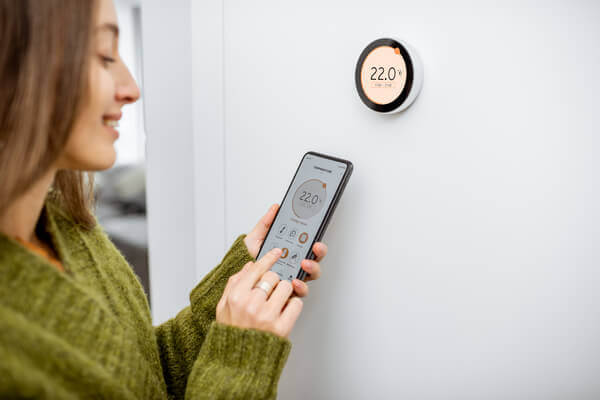
Winter is here, and along with the holiday season, it also brings an apprehension for high heating bills. If you have an electric baseboard heater, saving energy might be tricky, as the heater continues to work even when you’re not at home.
Installing a thermostat can help you regulate the temperature in your home. If you don’t know which thermostat is ideal for your home, look no further.
We’ve reviewed some of the best line voltage thermostats right here so you can make your choice.
-
List of the TOP 5 Line Voltage Thermostats
- 1. Mysa WiFi Smart Thermostat – Best for Electric Baseboard Heaters
- 2. Honeywell TL8230A1003 – Best Mid-Range Digital Line Voltage Thermostat
- 3. KING ESP230-R MAX22 – Best Programmable Electronic Line Voltage Thermostat
- 4. Stelpro Z-Wave Plus KI STZW402WB+ – Best User-Friendly Line Voltage Thermostat
- 5. Honeywell Home CT410B – Best Budget Line Voltage Thermostat
- A Guide to Voltage Smart Thermostats
List of the TOP 5 Line Voltage Thermostats
1. Mysa WiFi Smart Thermostat – Best for Electric Baseboard Heaters
Mysa is a well-known brand that produces high-quality thermostats, and this WiFi thermostat is one of its star products. The product claims to save at least 26% of your energy bills over the season.
If you’re bored with bland, beige thermostats, you’ll probably love the sleek and stylish look of this one. Apart from its subtle design, the programmable thermostat is highly productive. It can handle a heating system of more than 38,00 watts.
Furthermore, it is compatible with multiple heaters, including electric fan-forced convectors, electric baseboard heaters, and even hydronic baseboard heaters. Most importantly, the device is easy to install – you’ll love it if you’re a DIY enthusiast.
Pros:
- Online set-up guide available
- Works with Alexa, Google Assistant, and AppleKit
- Takes 15 minutes to set up
- Increases energy efficiency
Cons:
- Not compatible with 2-wire heating systems
2. Honeywell TL8230A1003 – Best Mid-Range Digital Line Voltage Thermostat
Honeywell is a famous go-to brand whether you need home appliances, safety products, or in this case, line voltage thermostats. Honeywell’s thermostat model helps you save 20% on your monthly energy bills by regulating your heating systems.
If you’re looking for a programmable thermostat to customize beforehand, this one allows you to save temperature settings for up to seven days in advance.
Additionally, this thermostat is designed for a quiet operation that eliminates the clicking noise produced by similar devices. For people who prefer a noise-free environment, this feature might be appealing.
Moreover, the device has a heating indicator and a backlit LED display. You can check the settings at any time and customize them according to your needs.
Pros:
- Easy maintenance
- Quiet operation
- Clear, backlit display
Cons:
- Requires professional installation
- May be tricky to customize and operate
3. KING ESP230-R MAX22 – Best Programmable Electronic Line Voltage Thermostat
This thermostat by King is one of the most advanced and affordable thermostats if you want good value for your money. It is easy to control because it doesn’t have any extra buttons and comes with a clear digital display.
Besides that, it can be programmed for up to seven days and has memory backup as well, so you won’t need to apply the same settings all over again. Similarly, the device saves your heating costs by up to 15% every month.
It is a three-wired line-powered device that takes no time or professional help to set up, which is great if you’re planning to set it up yourself.
Pros:
- Easy 2-button temperature control
- Full-size backlit display
- Compatible to most energy codes
Cons:
- It cannot turn the heater off
- Cannot be used with a 2-wire heating system
4. Stelpro Z-Wave Plus KI STZW402WB+ – Best User-Friendly Line Voltage Thermostat
Stelpro is a famous brand producing reliable line voltage thermostats, and this gadget is one of its best devices.
This smart thermostat combines ease of use with high productivity and lets you save up on your monthly energy bills during wintertime. If you want a remotely controllable device, you can integrate this thermostat into your home’s Z-wave network.
Through this technology, you can connect the thermostat to your door, window, and motion sensors so that it turns off and on accordingly. You can even control it from your phone or computer if you feel the need.
Furthermore, you can set your temperature levels for night and day time separately. Additionally, the device has an eco-mode that lets you save maximum energy while your heater is on.
Pros:
- Advanced automation
- High compatibility
- UL certified
- Remote controlling activated
Cons:
- Z-Wave remote control sold separately
- The Z-Wave operation will flood your phone with messages every minute.
5. Honeywell Home CT410B – Best Budget Line Voltage Thermostat
This line voltage thermostat is one of the most affordable models available if you’re on a strict budget. The device is easy to install and compatible with 120, 240, and 240V electrical baseboard systems.
Besides that, this high-voltage thermostat can control heating systems of more than 5,280 watts, which is the best you’ll get for this price. Moreover, the model is highly versatile and has a non-polarized connection. This means you can use it with both 2-wire and 4-wire connections.
However, this thermostat must be programmed mechanically, so you cannot program it for days ahead. You’ll have to renew the temperature settings manually whenever you need to.
Pros:
- Easy set-up
- Versatile
- Compatible with baseboard and convectors
Cons:
- Non-programmable
- No LCD display
- No remote controlling system
A Guide to Voltage Smart Thermostats
What is a Line Voltage Thermostat?
Line voltage thermostats are temperature regulation devices for smart homes. They can control the heating levels on electric space heaters, electric furnaces, convectors, and baseboard heaters.
Some line voltage thermostats are compatible with all types of heaters, while others come with some specifications.
There are two types of line voltage thermostats: single-pole wiring and others with double-pole wiring. Which one you should go for depends on the features and compatibility of your heater.
What is the Difference Between a Line Voltage Thermostat and a Low Voltage Thermostat?
You should know which thermostat is compatible with your home. There are two basic options available, low-voltage thermostats and line voltage thermostats.
Remember, you’ll risk damaging your heating system permanently if you didn’t choose correctly. Here’s a clear showdown of both to help you out.
Line Voltage Thermostats
A line voltage thermostat operates directly on your heater’s electricity. It can work with all kinds of baseboard heaters, convectors, and electric wall heaters. Typically, a line voltage thermostat can work with 120V-240V.
Most commonly, they have a four-wire system, also called the double-pole system. Besides that, you’ll find these thermostats sporting two-wire systems as well, but these are only compatible with specific heating systems.
Low Voltage Thermostats
On the other hand, a low voltage thermostat is a similar device with lower voltage usage. It can work with 24-30V and is compatible with some standard heating systems.
Low voltage thermostats are found more abundantly than line voltage thermostats because of their high compatibility, low energy consumption, and affordable price range.
However, if used with incompatible heating systems, they can end up damaging your entire temperature control system. You should check the information provided with your heating system to see which type of thermostat will work for your home.
Low voltage thermostats come with many variations, including bimetallic devices, digital devices, and programmable devices.
How to Tell Them Apart?
Now, if you already have thermostats installed in your home but can’t figure out their type, here’s a trick to help you differentiate. Low voltage thermostats have relatively thin wires, similar to telephone wires. But, line voltage thermostats have thick wires that need high voltage to function correctly.
Another way to find out the type of your thermostat is by looking at the inside of its cover. There, you’ll find its voltage listing, which can help you determine its type quickly.
Related Post: Honeywell Lyric T6 Pro Wi-Fi Thermostat
Single-Pole Vs. Double-Pole Thermostats
As we mentioned, line voltage thermostats have two basic types, single-pole and double-pole thermostats. While both of these work with high voltage and regulate your home temperature effectively, there’s a slight difference between the two.
Single-Pole Thermostats
If you look behind your thermostat device, you will find some wires attached to it. These wires connect the thermostat with your heating system.
Now, the thermostats with only two wires connecting to the circuit’s primary service line cannot turn your heating system off. This means it cannot break all sides of the power line, so even if your heater is not in use, it will stay on.
Nevertheless, it will turn your temperature level as low as possible when your heater is not in use. This way, even if the heater is not off, it won’t be using up as much energy as it would on high-temperature levels.
Double-Pole Thermostats
A double-pole thermostat can turn your heater off. Unlike the single-pole thermostat, it has four wires connected to the main circuit breaker rather than two. This helps the thermostat operate on two different circuits and break the heater’s power line from both sides.
That’s why this line voltage thermostat has a true switch off button to cut off your heater’s power when it’s not in use.
Which is Better?
If you’re looking for energy efficiency while installing a line voltage thermostat, you should go for the double-pole type. That’s because turning the heater off when it’s not in use saves more energy.
Read Also: Do High Temperatures Kill Germs?
The Benefits of Using A Line-Voltage Smart Thermostat
Line voltage thermostats are more expensive than low voltage ones and work with high voltage outlets only. But, they have some benefits you should consider before making a decision.
Savings on Energy Bills
Using line voltage smart thermostats will optimize the electricity you use for heating during the winter. It makes sure that your space stays warm without wasting any energy. Also, it provides multiple settings to help you customize your heating levels to avoid energy overuse.
Zoning Settings
Unlike low voltage thermostats, line voltage thermostats come with zoning settings. This feature allows you to regulate the heating level in each room. Not only does this help you cater to different preferences, but it also lets you lower the heating mechanism in empty spaces.
Remote Controlling
Line voltage thermostats are high-end devices that can be connected with your smartphones and computers. If you’re someone who tends to forget to turn off the appliances before leaving home, you might like this feature.
You can control your thermostats and customize your heating system wherever you are.









